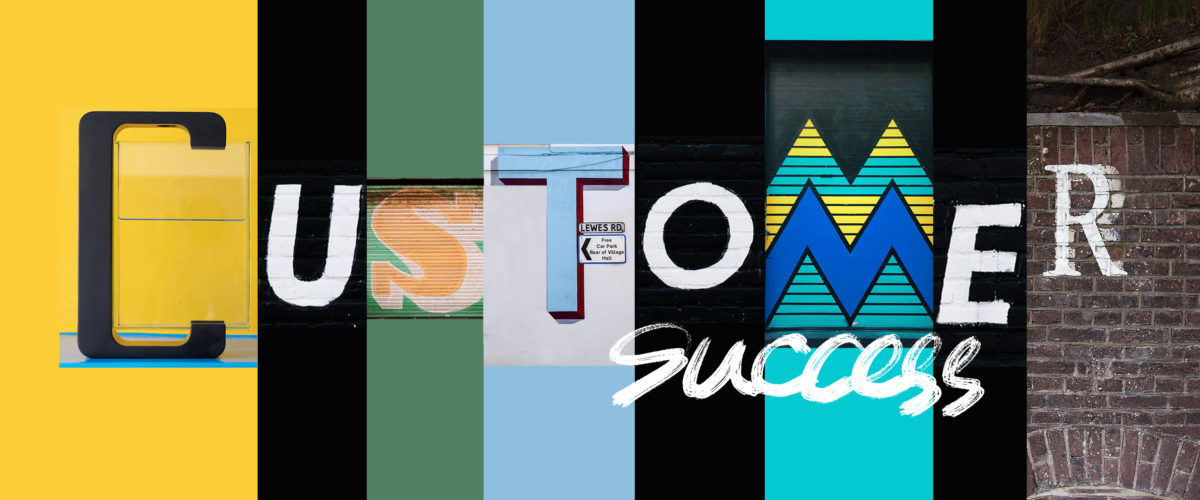Editor note: This article is based on a presentation Ingmar gave at SaaS Movement.
I was the first full-time customer success hire at ChartMogul.
4 years later, we’re a team of 7 people split between 3 sub-teams (customer advocacy, solutions engineering, and success management) and we help over 2,000 great companies measure, understand, and grow their recurring revenue.
Along the way, I’ve learned some things about building a great (remote) customer success team and in this article, I’m going to share them with you.
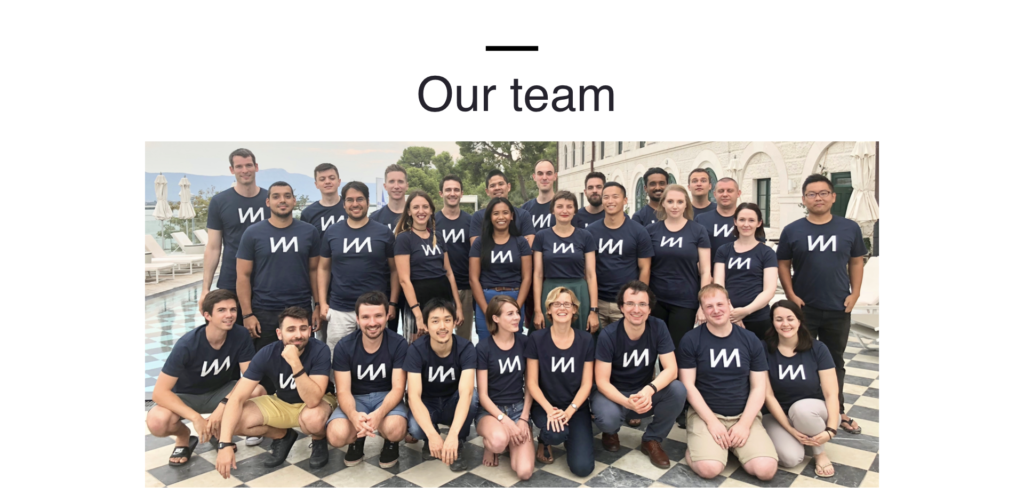
Today ChartMogul is a team of 35 people split between 15 different countries. Last year we decided to switch the company to a fully distributed team.
The customer success team, however, has been designed with remote in mind from the beginning. I’ll share some of the reasons for that decision below.
Before we get to it, I would like to tell you a bit about how we built our customer success team and how we ensured it works well with the rest of the company.
This article is divided into three sections:
- The first one is on building a customer success organization;
- Then I will discuss aligning departments with customer success;
- And in the last part, I will talk about working effectively as a distributed team.
Before I get into organizational building, I would like to make the connection between SaaS and customer success.
Why customer success is so important for SaaS companies
The subscription business is about building long-term relationships with your customers. The value of this relationship is realized over many months and even years.
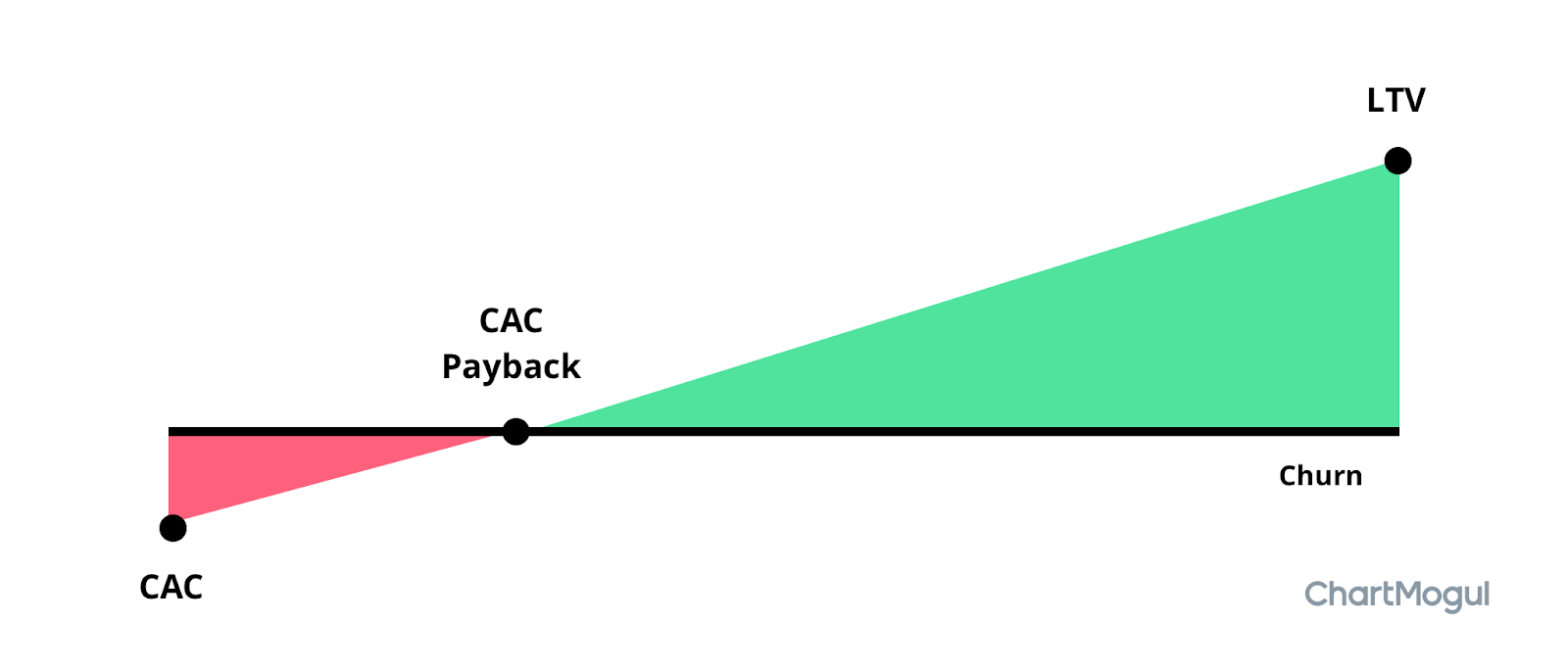
If you successfully manage this relationship, you can attain a predictable stable revenue growth that leads to a large ARR.
Putting customer success at the heart of your organization will enable this growth. Every department in your business can contribute to empowering your customers to achieve their desired outcomes. For example, the content team at ChartMogul contributes to customer success by educating our users on best practices on how to grow their business using SaaS metrics.
Building a customer success team in a SaaS organization
When I first started at ChartMogul, I was based in Berlin. The majority of our customers were in North America. This meant that I had to shift my hours in order to be responsive. I started working late in the evening so that I can support the East Coast time zone.
This is not a humblebrag about the struggles of startup life. Rather, it was the experience that led me to the realization that we needed to hire people remotely from the beginning in order to be able to bridge these different time zones.
And one thing that was a key learning for me there was to manage a team well it was really important to pick overlap. So we hired into both directions but I always had enough overlap into the time zones, I was working with, so I could easily talk to my team.
Integrate continuous feedback loops
Another area that that really helped (and is still helping us) scale our customer success effort at the beginning was to integrate continuous feedback loops into our workflows — both in an automated and in a manual way.
Running surveys like NPS and more transactional surveys like CSAT will help you improve your customer experience and understand it and also see where you are under-delivering.
These feedback loops also help you to get to product/market fit faster. Having some manual ones as well — like a really solid feature request workflow (so that your roadmap can be adapted quickly) — will accelerate this.
Then what we do also is to have a feedback channel so we collect qualitative information from our customers and pipe this in to share it with the rest of the company.
Lastly, we bring product managers into calls with our largest customers. This helps us to see where our customers are pushing the boundaries of what is currently possible with our software.
It also helps us understand where our next 100 customers will come from.
Enable self-service with great documentation
The next area that I think is an amazing return on investment that is often overlooked is to really double down on documentation.
We did this early on, we have a fairly technical product, and we look to companies like Slack and Stripe and see how they are serving their customers with their documentation.

We have a help center with over 100 articles, and we also have very detailed API documentation, which is in a separate developer doc.
We put a lot of effort into maintaining this — initially, it was really hard to make the time to build this up, but the discipline has paid off many times over.
A few months after relaunching this, we saw our support volume decrease rapidly for our self-service customers and the onboarding improved greatly.
Nail down your performance metrics
Another area that I would encourage you to focus on is to build up performance metrics for the different parts of your team.
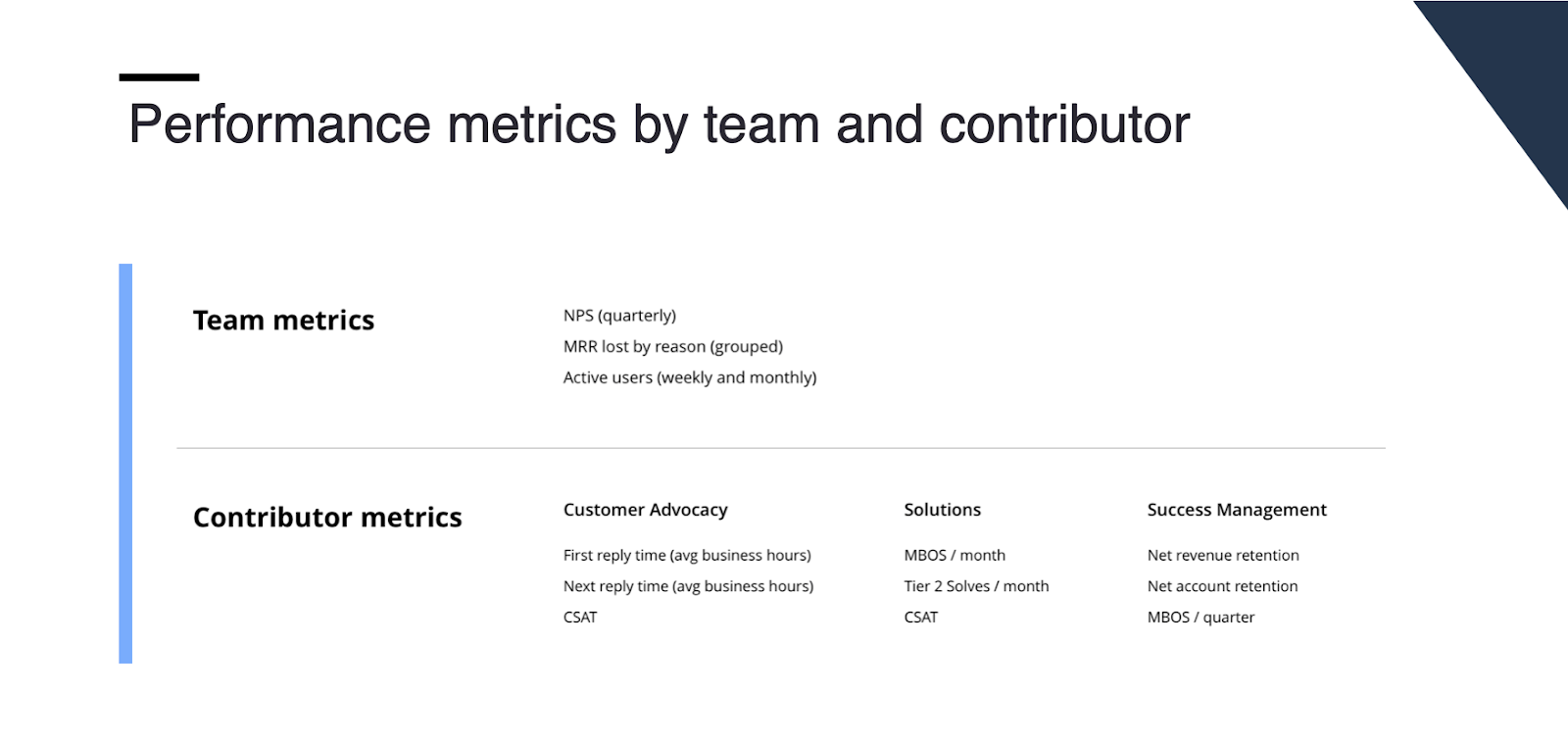
I had mentioned our team is split into three parts. We track high-level team metrics and individual contributor metrics.
Once you start measuring these KPIs you can set goals for different parts of your team. It makes it easy to hold everyone on the team (including managers) accountable for their achievements and to measure performance in an objective way.
This really helps when managing your team, because the expectations are very clear. These metrics should drive your growth and they should help improve your customer experience.
The metrics you pick to track would be specific to your company, but if you’re at the beginning and you are a cross-functional team, you might just want to pick one or two that really move the needle.
For us at the beginning, it was really important to be very responsive to customer requests for help and that’s why we focused on First Reply Time.
When we started tracking, we were doing alright — we didn’t really have the people on our team to be able to commit to an ambitious service-level agreement (SLA).
Once our team got large enough, we were at a point where we could say “Okay, we’re going to set an ambitious goal of having a first reply time during business hours in Europe and the US of less than one hour.”
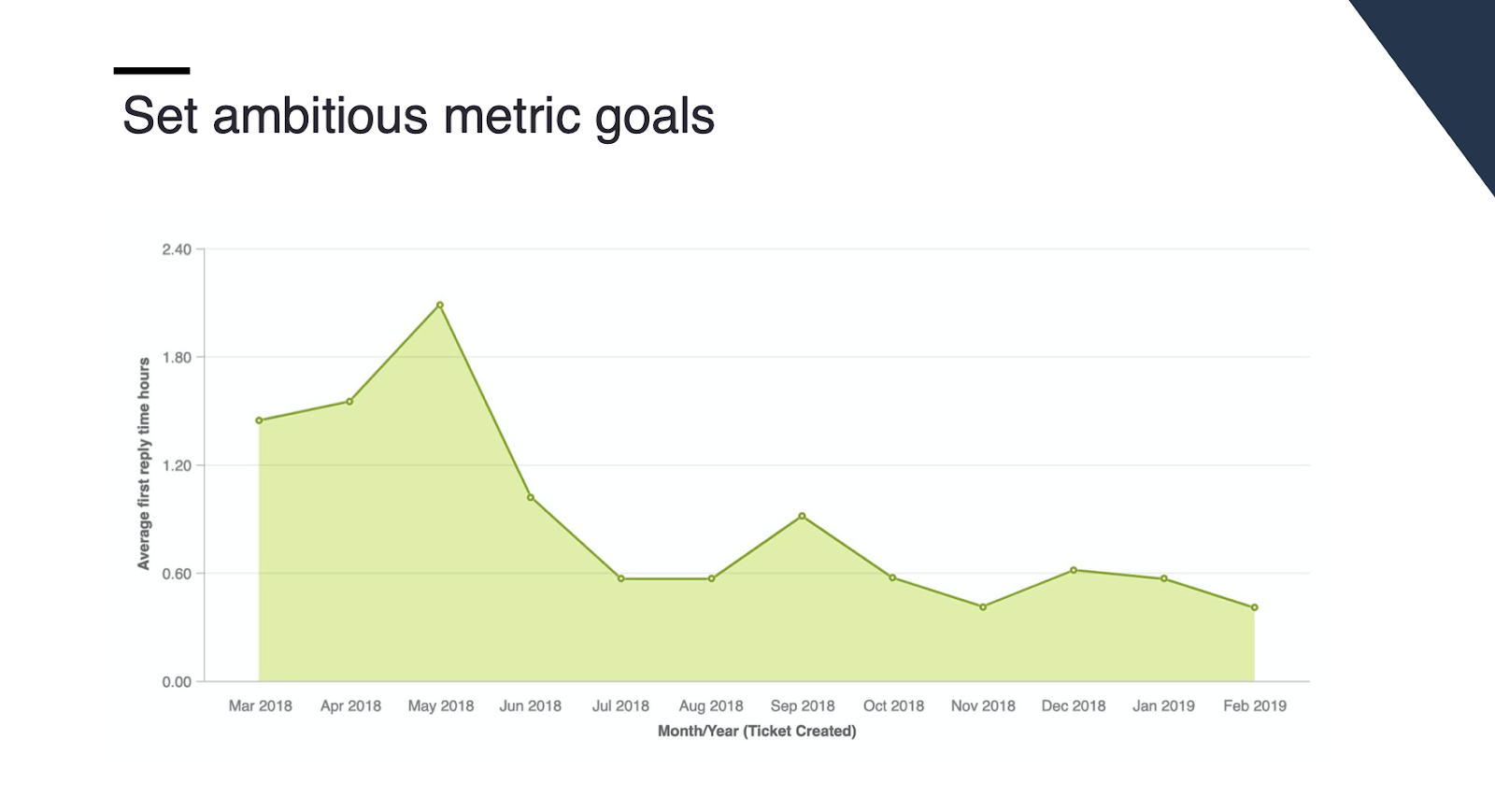
We achieved this goal within two months, and we have been under one hour ever since. Today, we’re actually closer to 30 minutes for our first reply.
This experience was really energizing for our team, so we took the learnings and applied service level agreements to all parts of the team.
We would look not only at the first reply time of our frontline advocacy team, but also the next reply time, and also at what happens with escalations, etc.
It goes even beyond the customer success team — we have metrics and SLAs that govern what happens when a customer communication goes to the product or the engineering team.
All this has really helped us improve the customer experience dramatically. But it wouldn’t have been possible without having buy-in from all parts of the company.
In the next section, I’d like to share some learnings from aligning departments with customer success.
Aligning departments with customer success
Customer success is really an organizational level goal and getting your CEO and the different departments on board will be necessary to succeed in it.
One way to do this is to build a data-driven company culture. Everybody cares about growth, so tracking metrics such as MRR, churn rates, retention rates, and then seeing how each part of the team can impact these different metrics will actually motivate the team to help you.
For us, this was about deeply understanding churn.
Churn is something that often is assigned to be owned by customer success but I would actually argue that churn is a company-wide metric.
Tweet this quote
Because very often, developing the product further is what actually leads to reducing churn. If you have really great product/market fit your churn will also automatically be lower. So it’s not just great (customer) service that will lower churn.
We do monthly and quarterly churn reporting and then segment the churn reasons based on self-service customers and managed accounts (which for us start at $1000 MRR or higher).
We map out retention-related activities for each department and then we’re driving these initiatives in order to lower churn.
Onboard customers with product marketing
One departmental activity that led to improving customer success was through our content marketing.
At ChartMogul content marketing was something that we did from the beginning, and it actually was a really inexpensive way to attract our first customers by establishing ourselves as an authority in SaaS metrics.
We published a lot of useful content like our SaaS metrics cheat sheets that we then could use in our onboarding. We would include this content in our onboarding emails and lead nurturing campaigns.
We also injected our content into notification emails that we send out to customers to notify them of MRR changes:
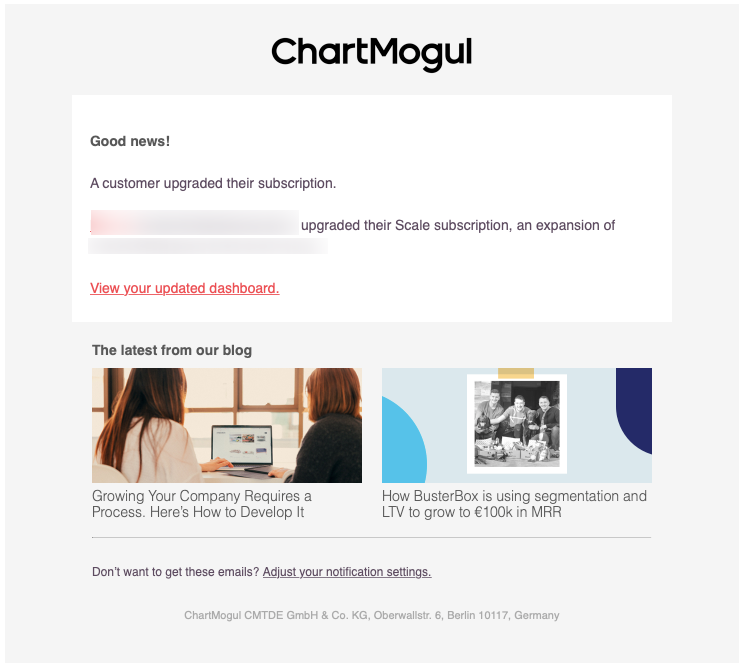
We send out millions of those emails each month — our goal with adding our content at the end is to help customers with continuous education and onboarding.
Turn your sales team into customer champions
The sales team has also been a great source of inspiration and improvement for our customer success department.
At ChartMogul, the sales team owns the relationship with a prospect up to the point of sale and then customers are funneled into self-service or managed accounts.
We designed a training program for our sales team that they run through when they start at ChartMogul. As part of this training, new team members assume the role of a customer and go through the whole buying process — integrating the software, adding their data, etc.
During the program, they will also be asked to do customer support and oversee all other critical functions of customer success to get hands-on experience of our work.
The purpose of this is to train them on how to sell on the full value of the product — not just the software, but how our team can help customers achieve their goals.
This is an ongoing process. We do product training on a weekly basis with our team members and these are run by different members of the success team.
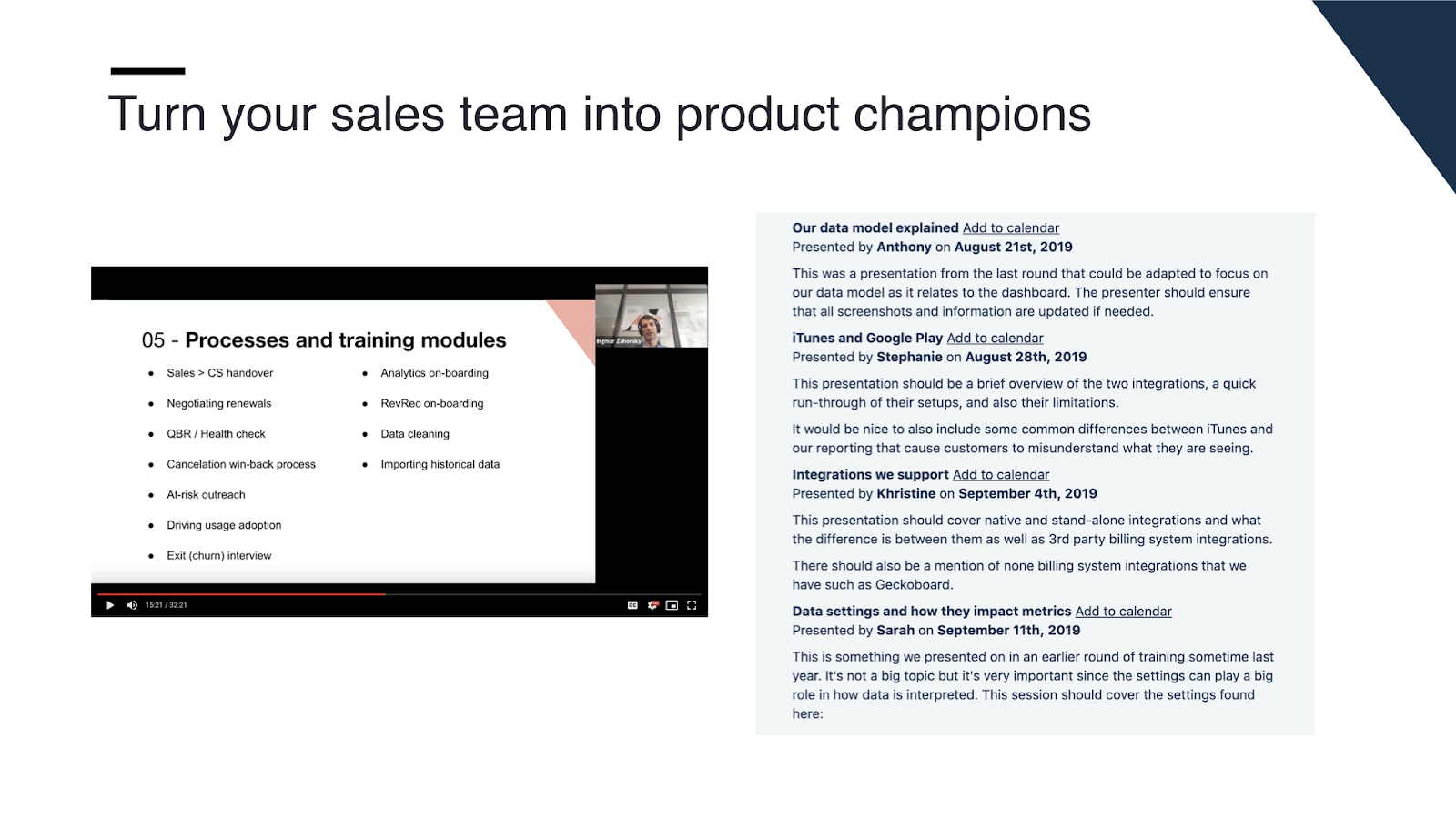
It’s a collaborative exercise for everybody from the success team — the whole sales team attends, and also the rest of the company is encouraged to participate in the sessions in order to learn more about the product.
This helps at conferences where you can have someone from HR or your finance team speak to a prospect — if they understand the intricacies offered, they can be promoters of your product wherever they go.
Get product and engineering in front of customers
The last area, I’d like to share is about getting product and engineering teams involved with your customers.
For us, that is bringing them closer, by taking them to conferences.

So here is our head of engineering talking to prospects to learn about their requirements and what outcomes they’re trying to achieve.
It changes the dynamics in our engineering team to also be customer-centric.
Working effectively as a distributed customer success team
In the last section, I’d like to talk to you about working effectively as a distributed team. This will also be relevant to you if you just have a satellite office or you have just a few people working remotely.
The challenge of working with a remote team is predominantly around communication and collaboration.
A lot of that can happen more organically in an office setting but when your team members are remote this can become challenging and it requires putting more thought into those areas.
For us, it meant to be really disciplined about how we communicate.
Roundups, standups, and one-on-ones
We silo stand-ups to the specific sub-departments in our success team so that every session is relevant and we do those on a weekly basis.
We also have one-on-ones at a higher frequency than we used to do when people were in the office with us. Depending on the role, this could be weekly or bi-weekly.
This helps to surface problem areas because if someone is unhappy about something or really needs help, they might not come to you directly. These one-on-one calls allow us to surface and address such issues quickly.
The last piece — this is the cornerstone that has really unified our team to create a singular mission — is to do success roundups every month. These happen as a Zoom call and they are also recorded for those team members who cannot attend.
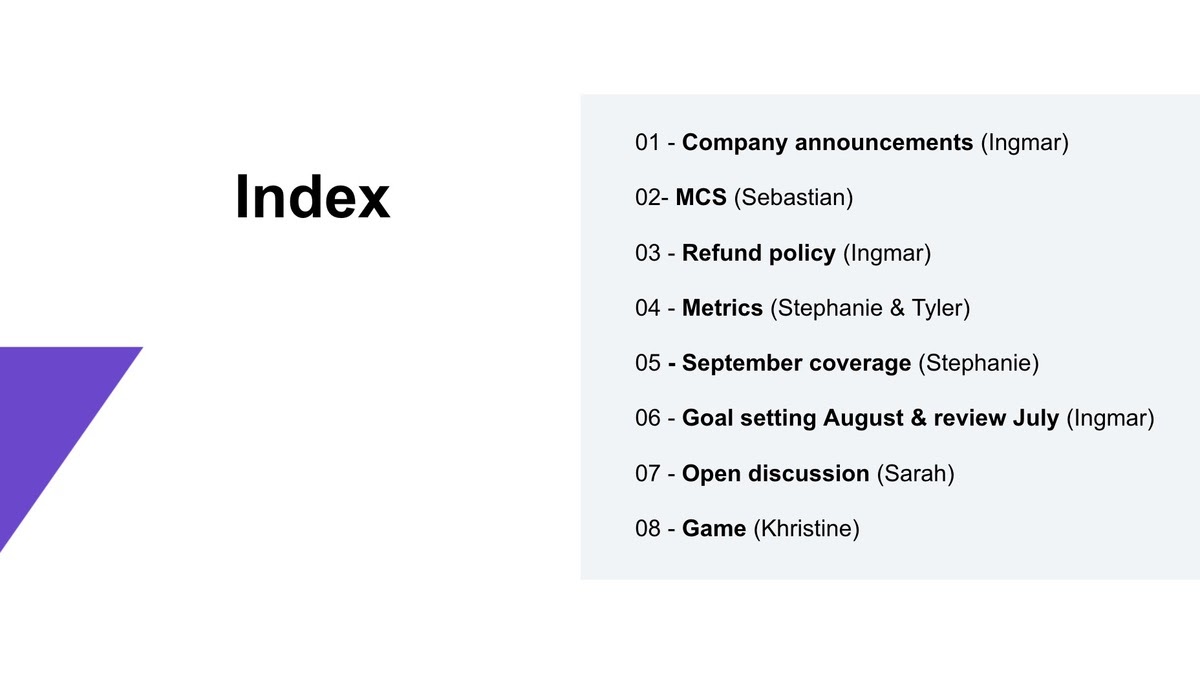
We put this together every single month — we look at our performance metrics, how we did in the last month, and if we want to update our goals and/or our policies.
We also do goal setting based on tasks that are assigned to the team as additional projects.
In addition to operational things and we also like to play a game or do something fun together, which is something that usually falls short in a remote setting.
Clearly defined processes
The other area around collaboration is to design clearly defined processes. I think it’s important to keep your process design simple for the stage of your startup.
A lot of the customer success content that you will find on the internet targets large businesses and suggests practices that may introduce unnecessary complexity.
It is important to implement processes that align with your growth stage and team size. Keeping things simple reduces touchpoints and generally results in better customer experience.
We have this for each subsection of our team for these three teams to have their own section within Notion (which we use for our internal documentation).
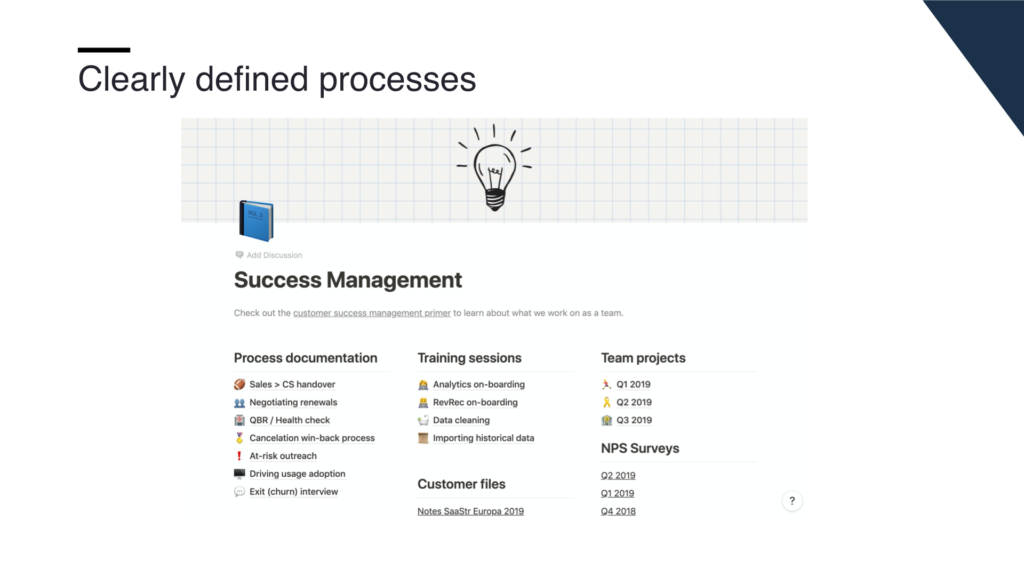
We found that this helps to create really clear expectations because when you work in a remote team, you can’t always speak to someone in real-time, because they might not be online. So, having things documented helps people make their own decisions when they’re not able to talk to someone.
Goal-oriented task setting
We also do goal-oriented task setting on a monthly basis. This is in addition to the operational work that we do.
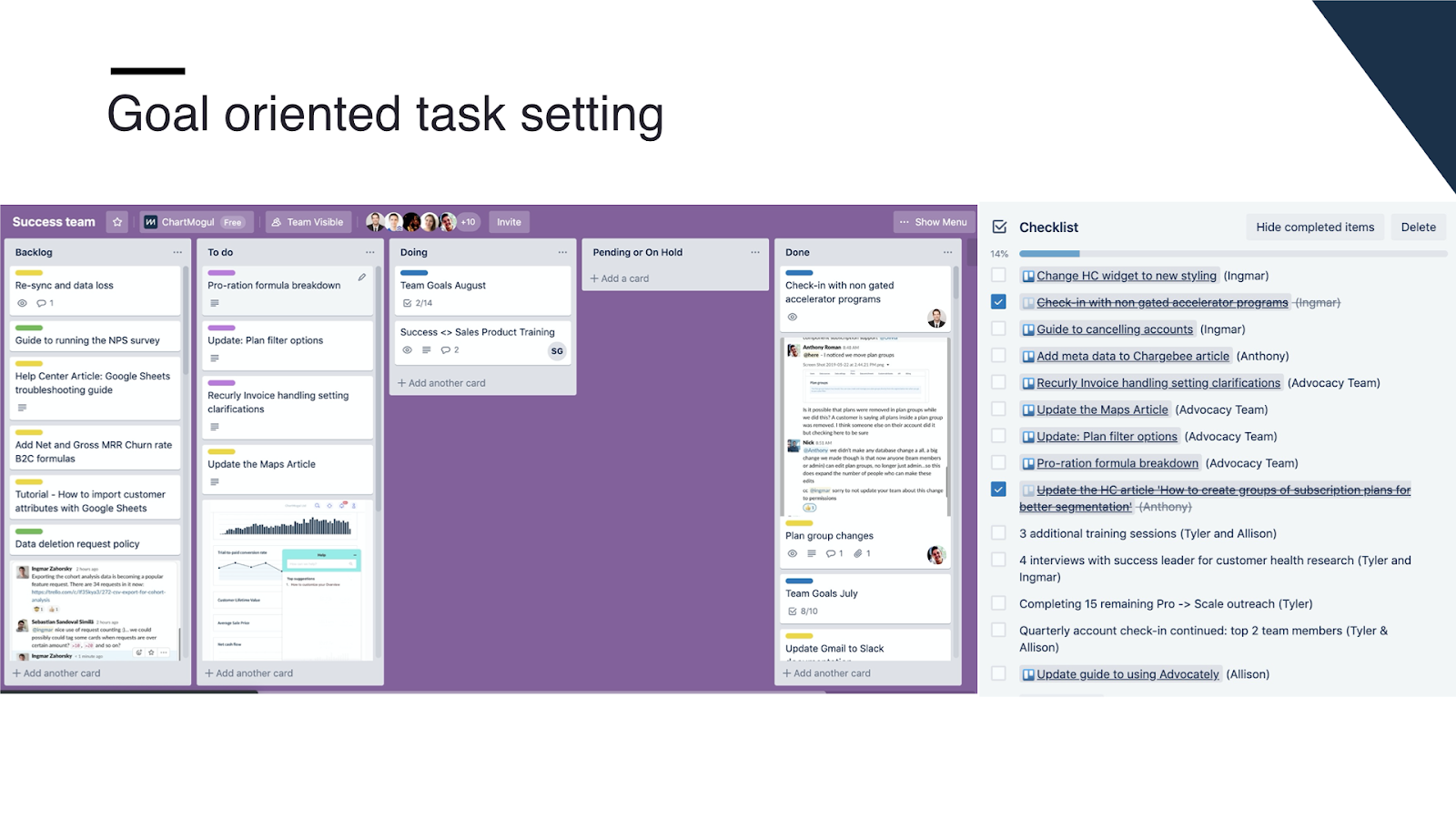
We use a Kanban board and we have a backlog that comes from the rest of the company and also from our team and from our customers.
We pick the projects we want to work on a monthly basis and then go through them and it has helped us achieve over 90% of these every single month.
This has been a great way to build a sense of ownership and to also make roles such as frontline customer support more fun when you can also do some project work on the side.
Have fun together
The last area, I would like to share is to make time to meet your team in person.
Fly in your remote team members to work with you at the office.
Consider doing something like an offsite to bring the whole company together.
This really helps to rally your team around the vision, and you can do sessions and team-building work that will really build the relationships within your team.
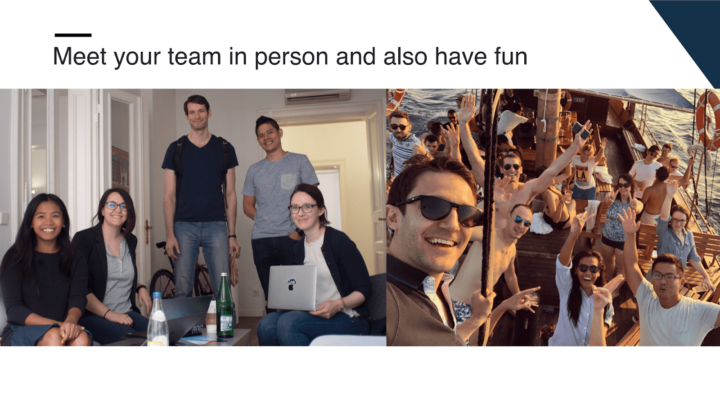
On the left here we have some of our success team working together in Berlin. The photo on the right is from Croatia — in 2018 we chartered a boat there and had a great time going to some beaches.
This year we’re going to Mallorca where we have rented a resort.
Of course, this is something where you have to keep your budget in mind of what you can do at the stage where you’re at, but you can get creative there: like having people share rooms or picking a destination that’s not too expensive.
One thing is important to note: the benefit of getting your team together and having them bond is times what you’ll be paying to fly and host everyone at the same place for a week.
Customer success will be your competitive advantage
If there’s just one thing you can walk away with, I would like it to be this one — start simple and evolve your team through fast feedback loops.
- Define goals and actionable performance metrics for each person and team;
- Establish a culture of customer success across your entire organization;
- And lastly, create clear processes that empower your distributed team.
In a SaaS startup, customer success will be your competitive advantage.
Thank you very much. You can find me on Twitter or LinkedIn. This is a very high-level article, so if you’re interested in talking deeper about one of these subjects, please get in touch.
